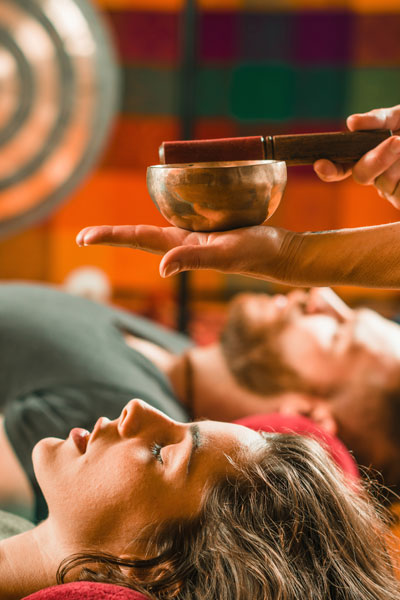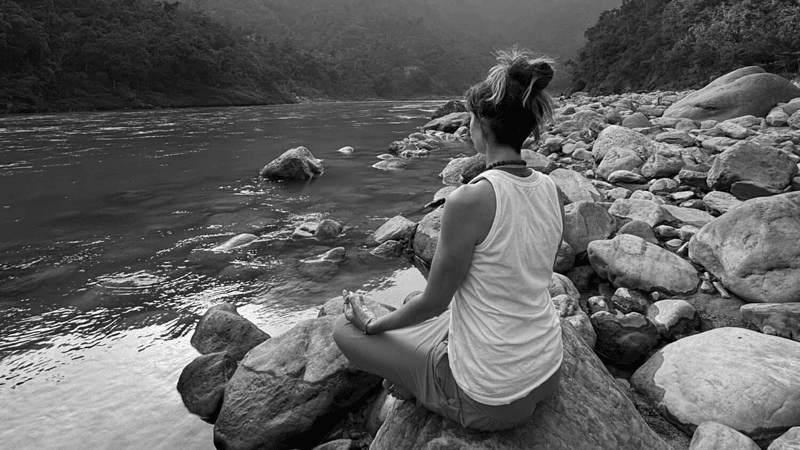
Sound Meditation - Find your inner silence in sound
Sound meditation: ancient wisdom for a modern world. Finding your inner silence. By Louise Wellby
We are on a quest for calm within the chaos; silence through noise, and rest in motion. We want to feel connected to ourselves and connected with one another — but we end up being connected all the time, at all costs, and we risk losing a deeper sense of connection along the way. As much as we crave silence, we also fear it.
We live in an increasingly plugged in, switched on world, a society that seems to require us to inhabit a highly reactive, racing forward state. Dominated by technology and the noise of continuous media streams, pollution, air travel and the whirrings of busy ‘non-stop’ minds, how can anyone possibly find silence within all the noise?
Yet we do seek it. No matter the extent of noise outside of us, it is the noise within us that we seek to settle, so that we may cultivate fluency in our being and through our chapters of life.
We are experts at distraction and multi-tasking, devouring media with a short attention span. We have collectively forgotten how to pause, unplug, be still and quiet.
All is not lost, however: the tools to achieve this quiet within are accessible and universal; the wisdom ancient and intuitive.
The sound portal
In search of contentment and tranquility, humans often seek to acquire some new status or material gain, thinking that beyond the next hurdle lies the eternal sunshine. The answer is not external, loitering out there somewhere. It cannot be bought. It defies the capitalist consumerist approach. The key to our quest for inner quiet lies in the pausing, the spaces between sounds, a state of balance, stillness.
There, we can dive into a quality of silence which is both the void and the source of creative potential: the experience of shunyia (a Sanskrit word meaning zero point, or the point of stillness).
Sound is a portal to a potent depth of presence and a silence that holds mystery, absorption, the innermost and universal, our truest nature in its arms. Sound and silence interweave; one cannot exist without the other, much like joy and sorrow, light and dark, life and death.
Although sound meditation may appear as a recent trend, in truth the use of sound as a meditative tool has roots tracing back to the musings and practices of ancient philosophers, priests, healers, physicians, geometrists and native tribes. Education, architecture, ceremony, medicine and healing were all inextricably bound to sound. Pythagoras (569-475 BC) used music as medicine, describing music as an expression of a divine principle (Harmonia) that brings order to chaos and discord in mind, body and soul. Pythagoras taught that healing was possible using sound and harmonic frequencies.
Through the ages
Across the spectrum of cultures and religions, stories are told of creation born from silence into sound; the power and creative potential of silence is a strong narrative thread. In the ancient Vedic texts, silence is broken with the cosmic hum we know as Aum/Om. Prayers and mantras are and have always been spoken, sung and chanted, whether the words belong to any of the Islamic, Hindu, Christian, Jewish, Buddhist or other traditions. Sufis, Shamans, Tibetans, Mayans and Tuvans, have used their voices to chant and overtone in ritual and healing work for centuries. Long before the scientific advances of recent times, our ancient ancestors understood that sound was sacred, potent and healing.
Sound meditation practitioners today work with sound as a powerful experiential practice to resonate with people on a cellular vibratory level. Rather than aiming to create a silent space, we use sound and, crucially, the spaces between sounds, to hold and convey the space within us all, and our capacity for silence, stillness, rest and transcendence.
Sound bathing
So what exactly is a sound bath and how does it work?
I’ll never forget my first gong bath and the whole being sense of attunement and serenity I felt. The experience usually involves resting comfortably, closing one's eyes and being immersed and enveloped in sound waves (no water!). These waves sound and vibrate through our bones, our cells, the very fibres of our being. Once the sympathetic nervous system is calmed and flows into a parasympathetic restful state, no longer caught up in mind chatter and hyper vigilance (fight or flight stress state), our imaginative, creative and intuitive capacities have room to surface and unravel.
The sound waves of the gong (and other ancient organic instruments and sounds) impact brain waves and people may experience a state of being vastly different from their everyday waking states. Deep sleep Delta state perhaps, or a Theta state, a space somewhere in between wakefulness and deep sleep, a liminal state. Experiences can include creative problem solving, trauma release and integration, the felt sense of the intellectual mind ceasing noise, an experience of ‘beingness’ as boundless and expansive.
Remember, the deep grooves laid out for us since ancient civilisation, we know it in our bones.
Sound bathing
The pathway to presence is one of slowing the pace, inviting a settling, experiencing the rich textures of this ever-unfolding aliveness and experiencing the sound of silence. Like our ancestors, we are vibrating, resonating beings.
The whole universe and all matter within it is in continuous motion and relationship. We are responding and recalibrating on a physiological level to sound all the time, ‘our voice, our breathing, our heart rate, and our digestion are all affected by [the vagus] nerve, which in turn is affected by sound’. (Leo Cosendai)
Sound is now used as a technology diagnostically (i.e. ultrasound, an inaudible frequency) and therapeutically (music therapy and sound meditation) to reduce stress and bring about better balance.
Such therapeutic practices are used to aid healthy brain function, mental health and to bring the body into the parasympathetic nervous system, a state of rest and recovery. The depths of the possible benefits of sound are an ocean which continues to be explored, including work with cancer patients, stroke patients, alzheimers and autism to name a few.
In our quest for calm within the chaos, silence through the noise and rest in motion, we need not invent something new. We need only to recognise the patterns and synergy in the natural world, in the galaxy, in our own systems and circulation.
In listening, in pausing, in silence, in sound, we witness rhythm and harmony and our integral part in it all.








